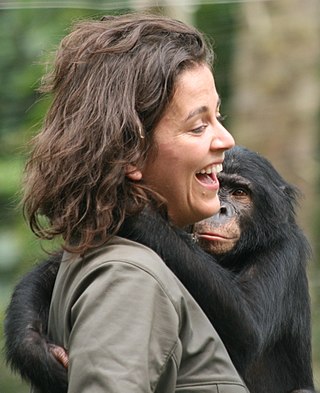Related Research Articles

Ardipithecus is a genus of an extinct hominine that lived during the Late Miocene and Early Pliocene epochs in the Afar Depression, Ethiopia. Originally described as one of the earliest ancestors of humans after they diverged from the chimpanzees, the relation of this genus to human ancestors and whether it is a hominin is now a matter of debate. Two fossil species are described in the literature: A. ramidus, which lived about 4.4 million years ago during the early Pliocene, and A. kadabba, dated to approximately 5.6 million years ago. Initial behavioral analysis indicated that Ardipithecus could be very similar to chimpanzees, however more recent analysis based on canine size and lack of canine sexual dimorphism indicates that Ardipithecus was characterised by reduced aggression, and that they more closely resemble bonobos.

The chimpanzee, also known as simply the chimp, is a species of great ape native to the forest and savannah of tropical Africa. It has four confirmed subspecies and a fifth proposed one. When its close relative the bonobo was more commonly known as the pygmy chimpanzee, this species was often called the common chimpanzee or the robust chimpanzee. The chimpanzee and the bonobo are the only species in the genus Pan. Evidence from fossils and DNA sequencing shows that Pan is a sister taxon to the human lineage and is humans' closest living relative. The chimpanzee is covered in coarse black hair, but has a bare face, fingers, toes, palms of the hands, and soles of the feet. It is larger and more robust than the bonobo, weighing 40–70 kg (88–154 lb) for males and 27–50 kg (60–110 lb) for females and standing 150 cm.

Homininae, also called "African hominids" or "African apes", is a subfamily of Hominidae. It includes two tribes, with their extant as well as extinct species: 1) the tribe Hominini ―and 2) the tribe Gorillini (gorillas). Alternatively, the genus Pan is sometimes considered to belong to its own third tribe, Panini. Homininae comprises all hominids that arose after orangutans split from the line of great apes. The Homininae cladogram has three main branches, which lead to gorillas, and to humans and chimpanzees via the tribe Hominini and subtribes Hominina and Panina. There are two living species of Panina and two living species of gorillas, but only one extant human species. Traces of extinct Homo species, including Homo floresiensis have been found with dates as recent as 40,000 years ago. Organisms in this subfamily are described as hominine or hominines.

Primates are a diverse order of mammals. They are divided into the strepsirrhines, which include the lemurs, galagos, and lorisids, and the haplorhines, which include the tarsiers and the simians. Primates arose 85–55 million years ago first from small terrestrial mammals, which adapted to living in the trees of tropical forests: many primate characteristics represent adaptations to life in this challenging environment, including large brains, visual acuity, color vision, a shoulder girdle allowing a large degree of movement in the shoulder joint, and dextrous hands. Primates range in size from Madame Berthe's mouse lemur, which weighs 30 g (1 oz), to the eastern gorilla, weighing over 200 kg (440 lb). There are 376–524 species of living primates, depending on which classification is used. New primate species continue to be discovered: over 25 species were described in the 2000s, 36 in the 2010s, and three in the 2020s.

The bonobo, also historically called the pygmy chimpanzee, is an endangered great ape and one of the two species making up the genus Pan. While bonobos are, today, recognized as a distinct species in their own right, they were initially thought to be a subspecies of Pan troglodytes, due to the physical similarities between the two species. Taxonomically, the members of the chimpanzee/bonobo subtribe Panina—composed entirely by the genus Pan—are collectively termed panins.

The genus Pan consists of two extant species: the chimpanzee and the bonobo. Taxonomically, these two ape species are collectively termed panins. The two species were formerly collectively called "chimpanzees" or "chimps"; if bonobos were recognized as a separate group at all, they were referred to as "pygmy chimpanzees". Together with humans, gorillas, and orangutans they are part of the family Hominidae. Native to sub-Saharan Africa, chimpanzees and bonobos are currently both found in the Congo jungle, while only the chimpanzee is also found further north in West Africa. Both species are listed as endangered on the IUCN Red List of Threatened Species, and in 2017 the Convention on Migratory Species selected the chimpanzee for special protection.
The killer ape theory or killer ape hypothesis is the theory that war and interpersonal aggression was the driving force behind human evolution. It was originated by Raymond Dart in the 1950s; it was developed further in African Genesis by Robert Ardrey in 1961.

Richard Walter Wrangham is an English anthropologist and primatologist; he is Professor of Biological Anthropology at Harvard University. His research and writing have involved ape behavior, human evolution, violence, and cooking.
Craig Stanford is Professor of Biological Sciences and Anthropology at the University of Southern California. He is also a Research Associate in the herpetology section of the Los Angeles County Natural History Museum. He is known for his field studies of the behavior, ecology and conservation biology of chimpanzees, mountain gorillas and other tropical animals, and has published more than 140 scientific papers and 17 books on animal behavior, human evolution and wildlife conservation. He is best known for his field study of the predator–prey ecology of chimpanzees and the animals they hunt in Gombe National Park, Tanzania, and for his long term study of the behavior and ecology of chimpanzees and mountain gorillas in Bwindi Impenetrable National Park, Uganda.

Emily Sue Savage-Rumbaugh is a psychologist and primatologist most known for her work with two bonobos, Kanzi and Panbanisha, investigating their linguistic and cognitive abilities using lexigrams and computer-based keyboards. Originally based at Georgia State University's Language Research Center in Atlanta, Georgia, she worked at the Iowa Primate Learning Sanctuary in Des Moines, Iowa from 2006 until her departure in November 2013. She currently sits on the Board of Directors of Bonobo Hope.
William M. Fields, also known by the lexigram , is an American qualitative investigator studying language, culture, and tools in non-human primates. He is best known for his collaboration with Sue Savage-Rumbaugh beginning in 1997 at the Language Research Center of Georgia State University. There he co-reared Nyota , a baby bonobo, with Panbanisha , Kanzi and Savage-Rumbaugh . Fields and Savage-Rumbaugh are the only scientists in the world carrying out language research with bonobos.

The Hominidae, whose members are known as the great apes or hominids, are a taxonomic family of primates that includes eight extant species in four genera: Pongo ; Gorilla ; Pan ; and Homo, of which only modern humans remain.
Kokolopori is a community of 35 villages in Djolu territory of Tshuapa province, Democratic Republic of the Congo. Kokolopori is an ethnically Mongandu Congolese community of about 24,000 people. It is located within the Kokolopori Bonobo Reserve, a 4,875 square kilometres (1,882 sq mi) community-based reserve using the Man and the Biosphere conservation model. The Reserve was established by a local nongovernmental organization, Vie Sauvage, together with an American partner organization, the Bonobo Conservation Initiative, and was formally recognized by the DRC government in 2009.
Takayoshi Kano is a Japanese primatologist, known for his pioneering work on the bonobo. He highlighted their peaceful communal lifestyle and the high frequency of sexual interactions. A student of Junichiro Itani, he was a professor at Ryukyu University and at the Primate Research Institute of Kyoto University. In 1973, he founded the first bonobo study center, at Wamba, Luo Reserve. It is the oldest bonobo research area and has survived a number of political upheavals in the region.

Isabel Behncke Izquierdo is a field ethologist who studies animal behaviour to understand other animals, as well as to understand humans and our place in nature. Originally from Chile, she is a primatologist, a pioneer adventurer-scientist and the first South American in following great apes in the wild. Behncke is currently director of the Centro de Estudios Públicos (CEP), and advisor to the Chilean government, working on long-term strategies in science, technology, innovation and knowledge as a member of the National Council of Science, Technology, Knowledge and Innovation for Development (CTCI), of the Ministry of Science, Technology, Knowledge and Innovation of Chile She is a board member of the PERC research institute, which is dedicated to promoting environmental conservation, Gruter Institute research fellow, researcher at the Social Complexity Research Center, Faculty of Government, Universidad del Desarrollo, and Member of the conservation area team at Estancia Cerro Guido in Chilean Patagonia.
The Pan African Sanctuary Alliance (PASA) is an association of wildlife centers in Africa, founded in 2000 in Uganda. The activities of PASA includes rescuing and caring for orphaned apes and monkeys, promoting the conservation of wild primates, educating the public, empowering communities, and working to stop the illegal trade in wildlife.

Brian Hare is a professor of evolutionary anthropology at Duke University. He researches the evolution of cognition by studying both humans, our close relatives the primates, and species whose cognition converged with our own. He founded and co-directs the Duke Canine Cognition Center.
Amy Parish is a Biological Anthropologist, Primatologist, and Darwinian Feminist. She has taught at the University of Southern California in the Gender Studies and Anthropology departments since 1999. She is recognised as being a world leading expert in bonobo studies.
The Kokolopori Bonobo Reserve is a nature reserve in the Democratic Republic of the Congo. The 4,875-square-kilometre (1,882 sq mi) reserve is a protected area for endangered bonobos and uses a community-based model of natural resource management undertaken by residents of the villages of Kokolopori and the local conservation organisation Vie Sauvage.
Primate archaeology is a field of research established in 2008 that combines research interests and foci from primatology and archaeology. The main aim of primate archaeology is to study behavior of extant and extinct primates and the associated material records. The discipline attempts to move beyond archaeology's anthropocentric perspective by placing the focus on both past and present primate tool use.
References
- ↑ "Home Page:Frances White". University of Oregon. 2008. Retrieved 2008-07-05.
- ↑ "Eros of the Apes" (PDF). BBC. Archived from the original (PDF) on 2008-05-16. Retrieved 2008-07-05. [When accessed on May 21, 2020, this link was no longer active]
- ↑ "Academic Phylogeny of Biological Anthropology". www.bioanthtree.org. Retrieved 2021-07-26.
- ↑ "NOVA | The Last Great Ape | PBS". www.pbs.org. Retrieved 2021-06-08.